Exploring the World of Berries: Health Benefits and Popular Varieties in North America
Posted on January 28, 2024 • 26 minutes • 5510 words
Table of contents
- Rubus Berry Varieties
- The Vaccinium Family within Ericaceae
- Nutritional and Phytochemical Profile of Berries
-
Health Advantages of Berry Consumption
- Berry Compounds and Antioxidant Properties
- Impact on Cardiovascular Health
- Neuroprotection, Neurodegenerative Disorders, and Aging
- Diabetes Management
- Berry-Based Cancer Therapeutics
- Therapeutic Benefits of Berry Bioactive Compounds
- Overview of Sea Buckthorn
- Blue Honeysuckle: Lonicera caerulea
- Exploring the Acai Palm
- References
From a botanical perspective, the term ‘berries’ specifically refers to pulpy fruits that develop from a single ovary enclosing seeds. Examples of true berries encompass bananas, grapes, and blueberries. However, in the context of this discussion, ‘berries’ are identified as small, tender, palatable, and vibrantly colored fruits primarily from the Vaccinium, Fragaria, and Rubus species. Berries are increasingly recognized for their substantial health contributions in diets. Predominantly consumed berries in North America are blackberries (Rubus species), red (Rubus idaeus) and black raspberries (Rubus occidentalis), blueberries (Vaccinium corymbosum), cranberries (V. macrocarpon), and strawberries (Fragaria ananassa). Consumption of other varieties like bilberries, lingonberries, goji berries (Lycium barbarum), and sea buckthorn (SBT; Hippophae rhamnoides) is less widespread. The growing popularity of certain exotic berries such as acai berries and honeysuckle (Lonicera caerulea) is also noteworthy. This exposition primarily delves into the widely favored berries in North America, particularly those from the Rubus and Vaccinium genera, along with a focus on select exotic varieties like acai berries, honeysuckle, and SBT.
Rubus Berry Varieties
The Rubus genus, part of the Rosaceae family, encompasses both blackberries and raspberries. This group, known as ‘brambles,’ includes not only blackberries and raspberries but also dewberries and various hybrid forms.
Global Cultivation and Characteristics of Blackberry (Rubus Species)
Globally cultivated, blackberries thrive best in areas with moderate summers and mild winters. They are predominantly grown in North America, Europe, Asia, South America, Central America, and Africa. Widely enjoyed fresh, blackberries also feature in desserts like ice cream and confectionery items such as jams and marmalades. The blackberry fruit is composed of numerous small drupelets, each holding a single seed, encircling a central core. Cultivation-wise, blackberries are divided into three main types based on their cane structure: erect, semi-erect, and trailing. Trailing blackberries, known for their robust growth and ground-laying canes, boast fruits rich in flavor and aroma with fewer seeds.
| Blackberries |
|---|
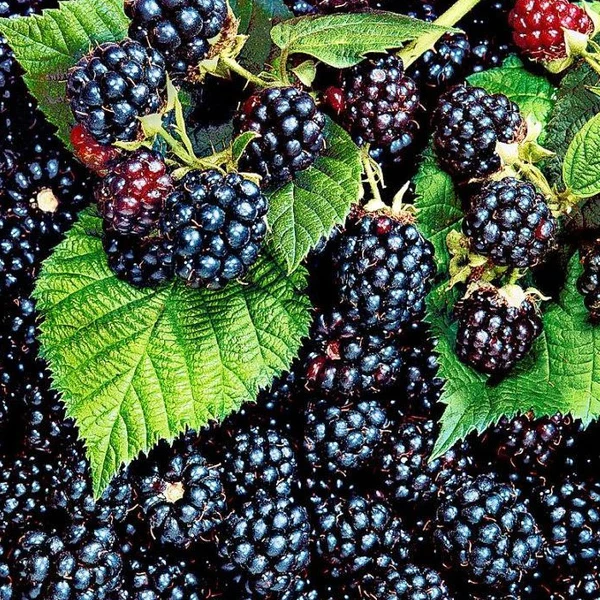 |
Semi-erect varieties, identified by their thornless, large canes, grow from a crown and bend towards the ground. Both semi-erect and trailing types produce new growth only from crown buds and bear fruit biennially. Erect blackberries, which can be either biennial or annual in fruiting, are characterized by their rigid, upright canes. Boysenberry and loganberry, classified as trailing types, are similar to erect varieties in berry quality but are more prolific. Nutritionally, blackberries are a rich source of vitamins, minerals, and bioactive compounds like polyphenols. They primarily contain sugars such as glucose, fructose, and sucrose, and malic acid as the main organic acid. Other acids like ascorbic, shikimic, fumaric, and succinic acids are also present. These organic acids are crucial in preserving the stability of anthocyanins and extending the shelf life of the berries. Blackberries are abundant in polyphenolics, including anthocyanins, ellagitannins, flavonols, flavanols, procyanidins, and phenolic acids, with phenolic content ranging widely across different studies.
The History and Cultivation of Raspberries
Raspberries, kin to blackberries, began their cultivation journey in Europe about 450 years ago. Major raspberry farming regions include Russia, Europe, and North America’s Pacific coast. These berries flourish in places with mild winters and lengthy, temperate summers. In North America, prominent red raspberry cultivation occurs in the Pacific Northwest (including Oregon, Washington, British Columbia), California, the eastern United States (New York, Michigan, Pennsylvania, Ohio), Mexico, and Guatemala. Commercially significant species include the European red raspberry (R. idaeus subsp. vulgatus Arrhen.), North American red raspberry (R. idaeus subsp. strigosus Michx.), and black raspberry (R. occidentalis L.). Unique varieties such as yellow raspberries, which are red genotype mutations, and purple raspberries, hybrids of red and black genotypes, also exist. Red raspberries enjoy wider cultivation compared to black raspberries, which are more regionally grown in the eastern United States. Raspberries are often enjoyed fresh, frozen, or processed, with red raspberries (R. idaeus) being more popular than black raspberries (R. occidentalis). Significant interspecific hybrids include tayberry, loganberry, boysenberry, and youngberry.
| Blackberries |
|---|
 |
Raspberry fruit formation involves each ovary developing into an aggregate fruit, ripening about a month post-pollination. Raspberry fruits are aggregates of multiple small drupelets, with the cohesiveness of these drupelets resulting from the intertwining of tiny hairs on their sides and base. Raspberry fruit sizes vary, typically between 1 to 5 grams. The ripening process is divided into three phases, each spanning approximately 10-12 days. Initially, rapid cell division occurs following pollination. Subsequently, cell division slows as the embryo and seed coat develop. The final phase sees a burst in growth due to cell enlargement, with ethylene production peaking and respiration diminishing during ripening.
Raspberries, both fresh and processed, are a staple in diets. Processed forms include quick-frozen, block-frozen, puree-frozen, canned, juice, concentrate, and preserves. Red raspberries are a powerhouse of beneficial compounds like essential minerals, vitamins, fatty acids, dietary fiber, and polyphenolic compounds such as flavonoids, phenolic acids, lignans, and tannins. Sugars, primarily glucose and fructose, constitute about 5-6% of the ripe fruit, with small amounts of sucrose. Red raspberries are energy-efficient, providing only 52 kcal per 100 grams. Their high fiber (6.5 g per 100 g) and fructose levels help in blood sugar regulation and satiation. The soluble solid portion of the fruit is roughly 9%.
The Vaccinium Family within Ericaceae
Belonging to the Ericaceae family, Vaccinium is an extensive genus comprising around 150 species. This genus is known for its variety of berry fruits like blueberries, huckleberries, cranberries, lingonberries, and bilberries. Among them, the most commonly cultivated are blueberries, large cranberries, and lingonberries. Vaccinium is typically classified into different subgenera and sections. For instance, the large cranberry (V. macrocarpon Ait) falls under the section Oxycoccus, while the section Cyanococcus includes cluster-fruited blueberries such as highbush blueberry (V. corymbosum L.), rabbiteye blueberry (V. ashei Reade), and lowbush blueberry (V. angustifolium Ait.). Additionally, other species like V. myrtillus L. (known as bilberry and whortleberry) are categorized in the section Myrtillus. V. vitis-idaea, belonging to the section Vitis-idaea, is primarily harvested from wild sources.
The American Cranberry: V. macrocarpon Ait.
Known as the American cranberry, V. macrocarpon Ait. is a red-fruited species of Vaccinium predominantly found in North America. This species is chiefly cultivated in the United States and Canada, with additional production in Argentina, Chile, and the Netherlands. The cranberry plant is an evergreen, woody, perennial, and mat-forming shrub, reaching up to 7 feet in length with a sprawling growth pattern. Its pink flowers develop on young, upright shoots, with buds forming in late summer and blooming in the following midsummer. The flowers mature into bright red berries with a glossy, hard skin by late autumn. Harvesting typically occurs from September to early November. Cranberries are gathered by flooding the fields and using a harvester to dislodge the berries, which are then cleaned, graded, and stored. They can be preserved for several months, especially at 0°C, which extends their shelf life significantly.
| Cranberry |
|---|
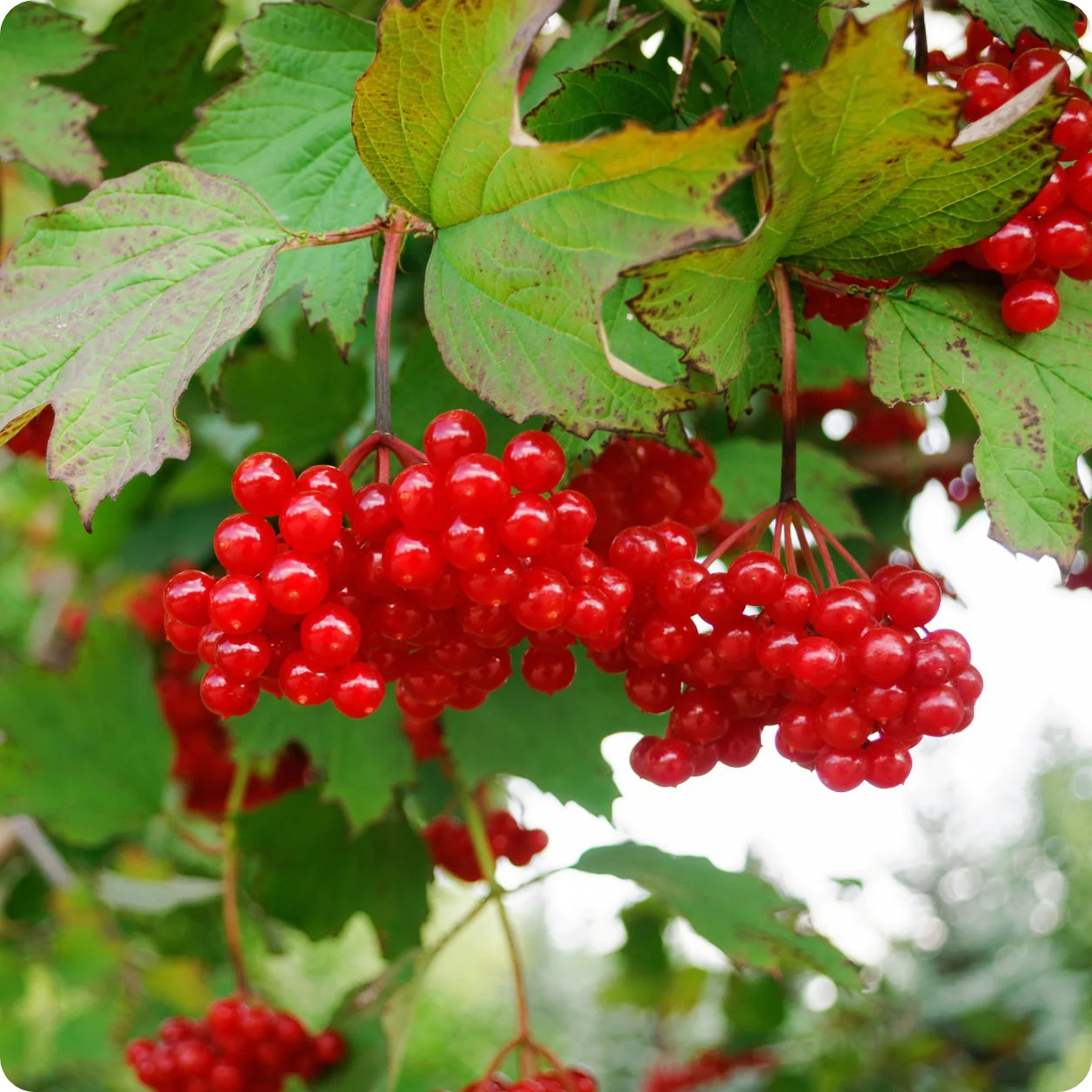 |
Cranberry pulp is a mix of lignin, glucose, fructose, and sucrose. In ripe berries, acids constitute about 2-3% (weight/weight), with citric acid being the predominant organic acid. Cranberries also contain quinic, citric, malic, and benzoic acids. Their tartness leads to most cranberries being processed into juice, sauce, jam, or dried products. Cranberry juice is often mixed with other fruit juices to mitigate its tartness, and cranberries are also used to make compote or jelly, known as cranberry sauce. They have about 1.2% pectin content. The edible part of the cranberry consists of 2.66% glucose, 0.74% fructose, and 0.14% sucrose. Additionally, the cranberry pulp includes lignin, glucose, arabinose, and xylose. The total acid content in ripe cranberries ranges between 1% to 2%.
The Diversity of Blueberries in the Vaccinium Genus
Blueberries, belonging to the Vaccinium genus and Cyanococcus subgenus, are among the most favored berries. They vary from wild lowbush blueberries (V. angustifolium) to cultivated highbush varieties. Cultivated blueberries include species like V. corymbosum L., V. angustifolium Ait., and V. virgatum Ait. The rabbiteye blueberry, V. virgatum (V. ashei), falls under the highbush category, with the northern highbush blueberry being V. corymbosum. Highbush blueberries are extensively farmed in regions including the United States, Canada, Europe, Australia, New Zealand, Chile, and Argentina, whereas rabbiteye blueberries are mainly grown in the southeastern United States. Production of lowbush blueberries is primarily in Maine, USA, and in Quebec and the Maritime provinces of Canada.
| Blueberry |
|---|
 |
Blueberry flowering starts in early spring, leading to fruit development that follows a double-sigmoid growth curve. The fruit, containing 1–50 seeds, grows as racemes or corymbs with a waxy cuticle. The development stages of the fruit include immature green, greenish white, greenish pink, blue-red, and finally blue, ripening in about 40-60 days. Blueberries are popular both as fresh dessert fruits and in baked goods. They are also processed into jams, pies, syrups, juices, soft drinks, and wines. Hand-harvesting is common for fresh market Vaccinium fruits, whereas mechanical harvesting is used for processed highbush and rabbiteye berries.
Blueberries have a composition of 3.5% cellulose and 0.7% soluble pectin, with over 10% of their fresh weight being total sugars, primarily glucose and fructose. The acid content in ripe blueberries ranges between 1% and 2%, with citric acid (1.2%) being the dominant organic acid. Blueberries are also rich in the amino acid arginine and contain 22.1 mg of vitamin C per 100g.
Bilberry: The European Counterpart
V. myrtillus L., known as bilberry, dwarf bilberry, or whortleberry, shares similarities with North American lowbush blueberries. Native to northern and central Europe, bilberries also grow in parts of North America and Asia. This small perennial deciduous shrub, with slender branches emerging from a creeping rhizome, features bright green leaves and globular, waxy flowers with pale green or pinkish petals.
| Billberry |
|---|
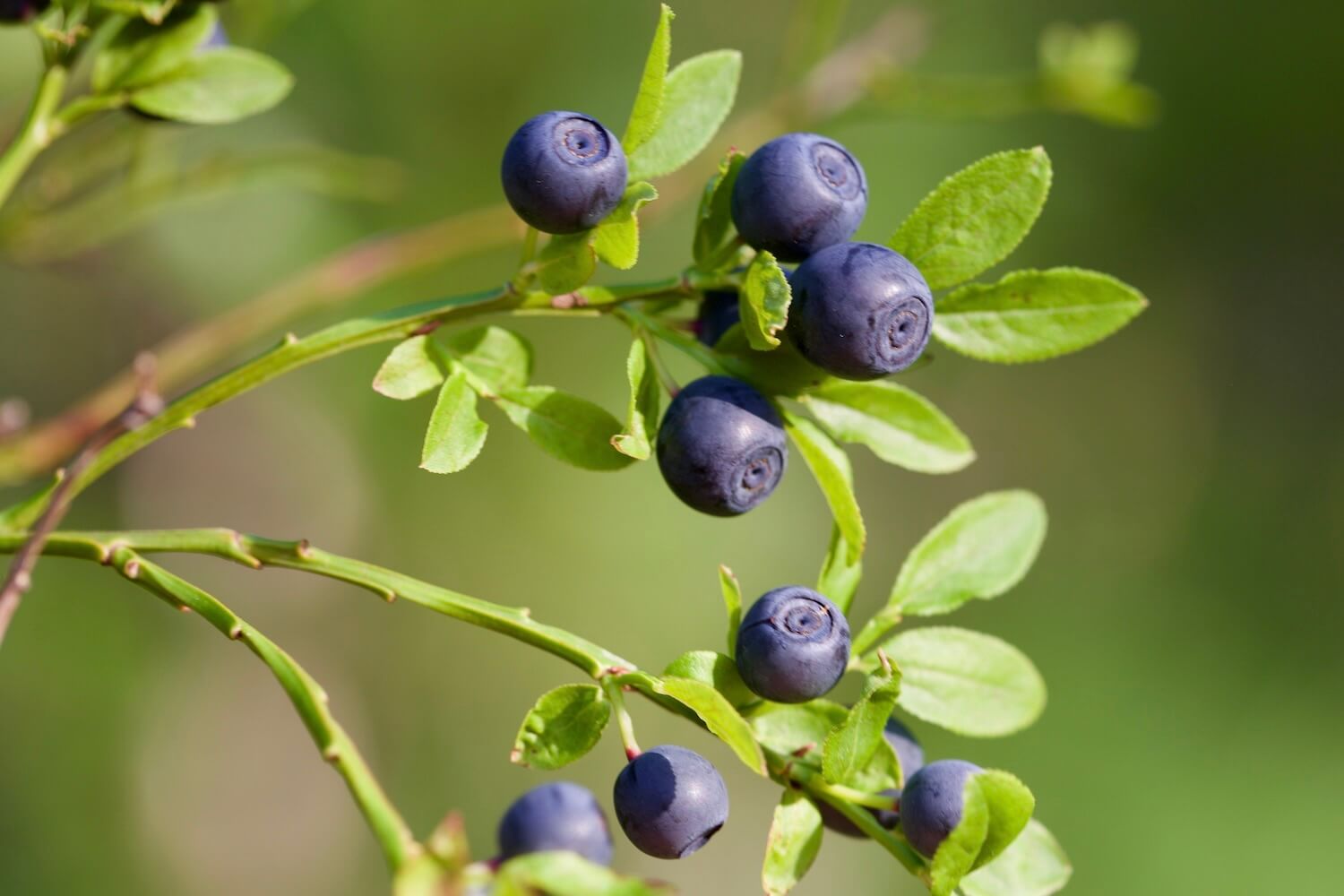 |
The berries are bluish-black, globular with purple flesh, brownish-red seeds, and sometimes a gray bloom. Bilberries typically grow singly at the base of the plant’s shoots. Wild-harvested in Finland and other European countries, bilberries are used in pies, tarts, syrups, jellies, and wines, and have a long history in medicinal applications. They are rich in amino acids like glutamic acid and valine, and their phenolic compounds include flavonols (quercetin and catechin), ellagitannins, tannins, anthocyanins, and phenolic acids. Bilberries have a notably higher anthocyanin content compared to other berries, with totals ranging from 300 to 700 mg per 100g.
The European and Newfoundland Favorite: Lingonberry
Lingonberry, known scientifically as V. vitis-idaea, is a favorite in Europe and Newfoundland. This perennial, evergreen shrub thrives in acidic soils and is found across the circumboreal regions. While traditionally harvested in the wild, lingonberry cultivation has recently become more domesticated. These plants are resilient in cold climates but do not fare well in heat.
| Lingonberry |
|---|
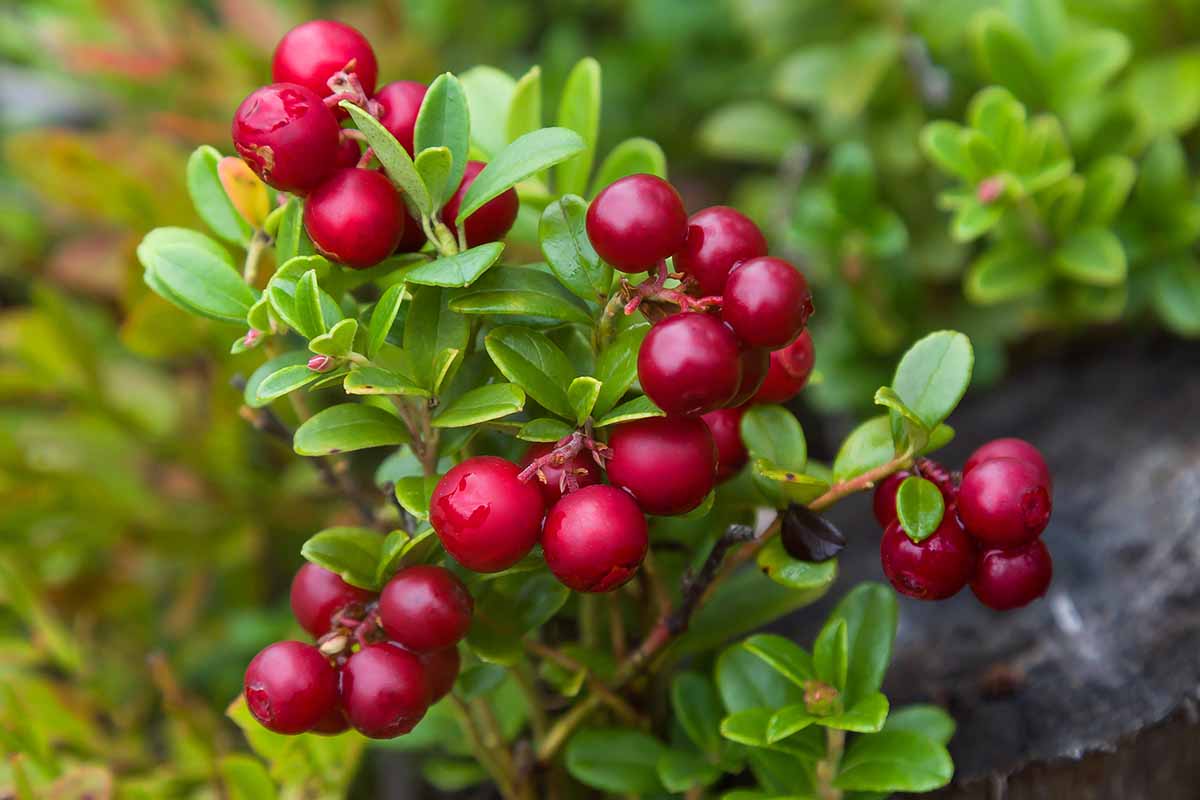 |
Commercial cultivation of lingonberries is widespread in various European countries, Scandinavia, and has also expanded into the United States. The leading exporters of lingonberries include Sweden, Finland, and Russia. While raw lingonberries are tart, they become palatable when cooked or processed, commonly appearing in juices, pies, and jams. These berries are rich in anthocyanin glycosides, and notable amino acids found in them include serine and gamma-aminobutyric acid. Additionally, lingonberries contain considerable amounts of benzoic acid. Traditionally, lingonberries have been utilized for their medicinal properties in treating inflammation, wounds, stomach ailments, and rheumatism.
Nutritional and Phytochemical Profile of Berries
Berries are not only a rich source of essential vitamins and minerals, but they are also abundant in various bioactive phytochemicals and antioxidants, including phenolic compounds and triterpenoids. The nutritional composition of select berries is detailed in Table 1. The content of phenolic compounds in berries varies significantly, making them a vital source of such compounds in our diet. These include flavonoids (such as flavonols, flavones, flavonones, flavanols, and isoflavonoids), stilbenes, tannins, and phenolic acids (derivatives of benzoic and cinnamic acids). Research indicates that the variety of the fruit and its ripeness stage can influence the profile and concentration of phenolic compounds. In the Vaccinium genus, for example, the relative quantities of anthocyanins, flavonols, hydroxycinnamic acid derivatives, and proanthocyanidins differ among bilberries, cranberries, and lingonberries, with hydroxycinnamic acid derivatives being particularly abundant in blueberries and huckleberries.
| Nutritional composition of some selected berries (100 g fresh-weight edible portion) |
|---|
 |
Anthocyanins in Berries
Anthocyanins, a subgroup of flavonoids, are a major group of water-soluble pigments found extensively in berries with red, purple, or blue hues. They consist of aglycones (anthocyanidins) and their glycosides. Serving as antioxidants, anthocyanins also play roles in modulating signal transduction and gene expression, and exhibit strong anti-inflammatory properties.
| Athocyanin in Califlower |
|---|
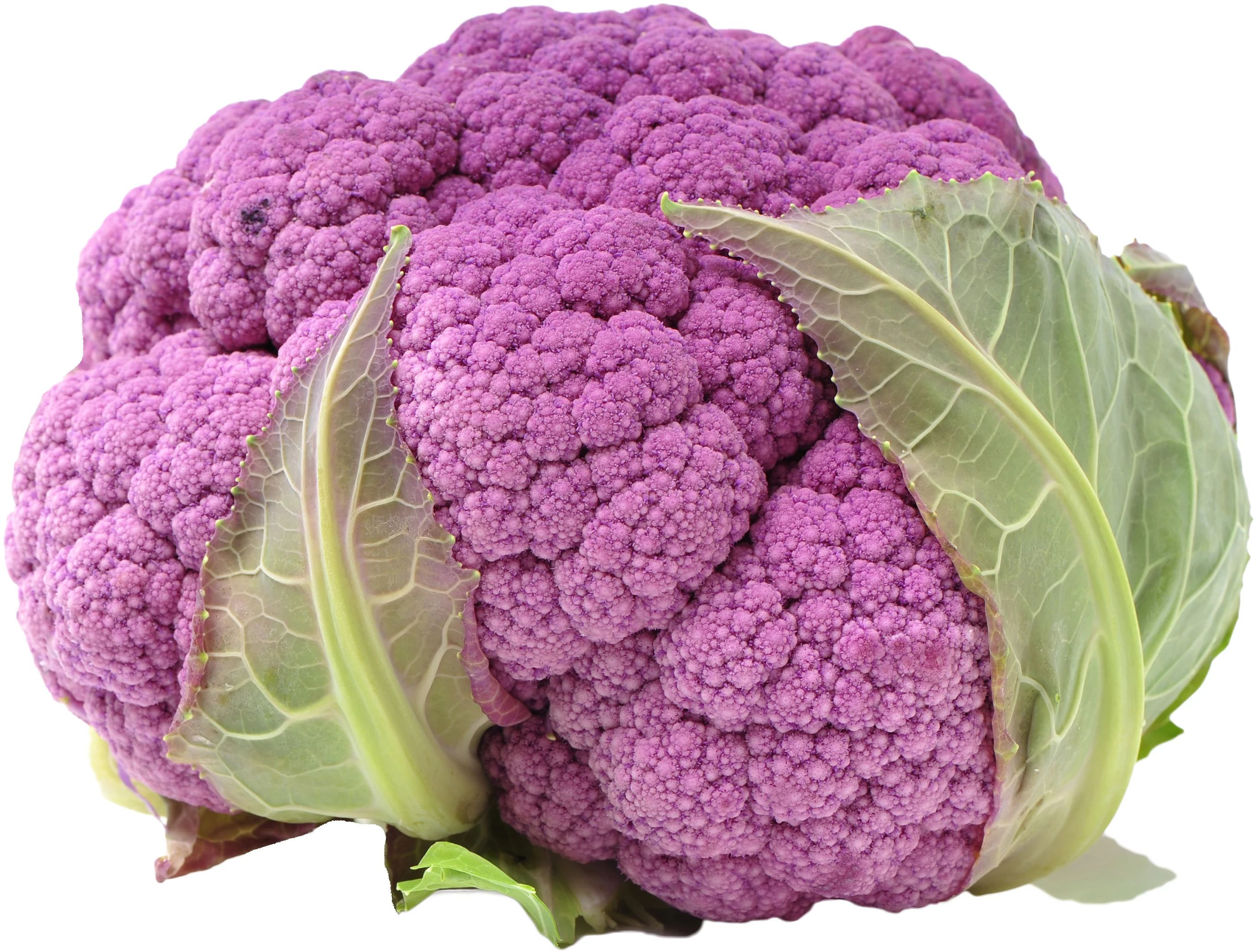 |
They typically appear as mono-, di-, or triglycosides, often substituted at the C3 position, and less frequently at C5 or C7. Vaccinium species, like bilberries and cranberries, along with black and red currants and gooseberries, are rich in anthocyanins. For instance, cranberries contain 13 identified anthocyanins and are a primary source of peonidin in the American diet. The main anthocyanins in cranberries are 3-O-galactosides and 3-O-arabinosides of cyanidin and peonidin, with total anthocyanin content ranging between 25 to 100 mg per 100 g of fruit.
| Athocyanin in Pansies |
|---|
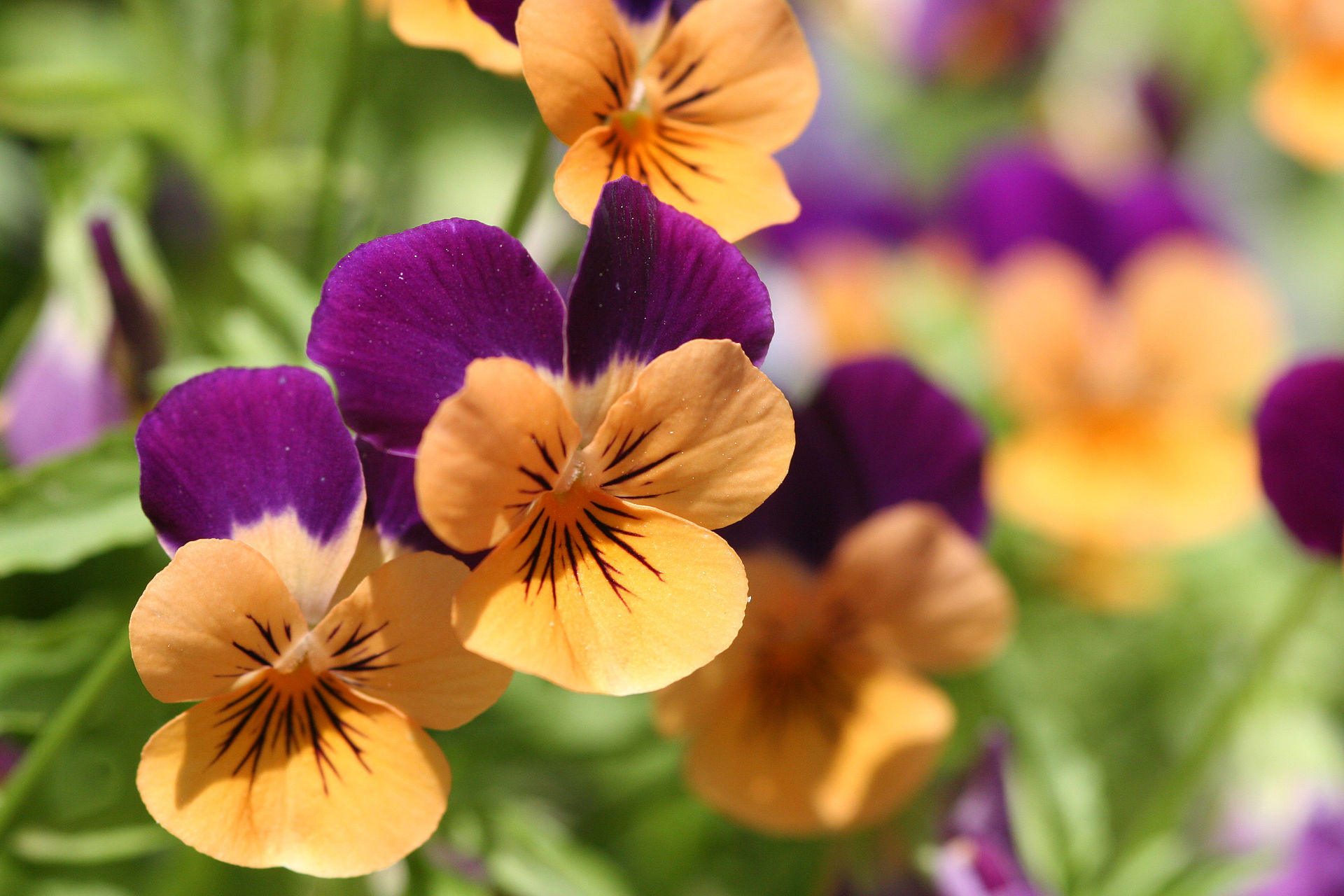 |
The anthocyanin profile in blueberries includes over ten types, whereas chokeberries, strawberries, and raspberries exhibit less variety. Blueberries have an anthocyanin content ranging from 85 to 270 mg per 100 g FW. Blackberries feature 3-glycosidic derivatives of cyanidin, delphinidin, malvidin, petunidin, and peonidin, with cyanidin-3-dioxaloylglucoside being unique to them. Raspberries are particularly rich in cyanidin glycosides. In blueberries, malvidin-3-galactoside is the most prominent anthocyanin. Cranberries' notable anthocyanins include cyanidin-3-monogalactoside, peonidin-3-monogalactoside, cyanidin-3-monoarabinoside, and peonidin-3-monoarabinoside. Cowberries are abundant in cyanidin-3-galactoside, while bilberries are high in hydrocinnamic acid and various forms of quercetin 3-glucoside.
Berry Phenolics: Acids and Flavonols
In berries, phenolic acids play a key role, mainly consisting of derivatives of cinnamic and benzoic acids . Benzoic acid derivatives in berries include elements like p-hydroxybenzoic acid, salicylic acid, gallic acid, and ellagic acid. The typical derivatives of cinnamic acid found in these fruits are p-coumaric acid , caffeic acid , and ferulic acid. Chokeberry, for example, is rich in derivatives of hydroxycinnamic acid, predominantly chlorogenic acid and neochlorogenic acid. In red raspberries, ellagic acid and its derivatives are the primary phenolic acids, while strawberries are rich in p-hydroxybenzoic acid and p-coumaric acid. Raspberries and strawberries notably have high concentrations of ellagitannins . In cranberries, hydroxybenzoic acid leads, followed by hydroxycinnamic acid. Both cranberries and blueberries are particularly abundant in ferulic acid. Bilberries contain significant amounts of p-coumaric acid and ferulic acid. In blackberries, the phenolic acids are mainly hydroxycinnamic acid and hydroxybenzoic acid, with their content ranging from 7 to 64 mg per 100 g fresh weight.
In terms of flavonols, raspberries contain quercetins and kaempferols. Strawberries predominantly have kaempferol, followed by myricetin and quercetin. A major portion of flavonols in these fruits, about 85%, are condensed tannins or procyanidins. Blackberries have a complex flavonol profile with numerous quercetin and kaempferol derivatives and other quercetin-related compounds. Cranberries feature flavonols as monomers, oligomers, and polymers, primarily comprising glycosides of quercetin, myricetin, and kaempferol, with quercetin 3-galactoside being the most prevalent. Cranberries are rich in various forms of quercetin, particularly quercetin galactoside, and their total flavonol content varies from 20 to 30 mg per 100 g fresh weight. Both blueberries and cranberries are also abundant in proanthocyanidins. Research indicates that quercetin and its derivatives possess potent anticancer properties, shown in studies against various cancer cell lines, including breast, colon, pancreas, and leukemic cells. The anticancer mechanisms of quercetin involve apoptosis induction, reduction of epidermal growth factor receptor expression and tyrosine kinase activity, decreased ras protein expression in colon cancer cells, and increased matrix metalloproteinase expression. Quercetin significantly contributes to the antitumor properties of cranberries.
Phenolic Compounds: The Role of Stilbenes in Berries
Stilbenes, a type of phenolic compounds, are found in several berry types. Notable among these are blueberries, cowberries, lingonberries, and acai berries, which contain stilbenes like resveratrol, pterostilbene, and piceatannol. These compounds are known for their strong biological effects, including anti-inflammatory, anti-aging, antiallergenic, anticarcinogenic, and antimutagenic properties. Research indicates that resveratrol can enhance the apoptosis of cancer cells by increasing their sensitivity to tumor necrosis factor alpha (TNF-a) and decreasing NF-kB activation. In various blueberry species like V. corymbosum, V. ashei, and V. angustifolium, concentrations of resveratrol can reach up to 860 ng per gram of dry fruit weight. Similarly, cranberries have been found to contain about 900 ng of resveratrol per gram of dry fruit weight. Pterostilbene and piceatannol, two derivatives of resveratrol, are present in significant amounts, ranging from 100–420 ng per gram in fruits like rabbiteye blueberries (pterostilbene) and highbush blueberries (piceatannol). These derivatives also demonstrate anticarcinogenic effects that are comparable, if not superior, to those of resveratrol.
Absorption and Metabolism of Polyphenols
In the human diet, only about 0.5-1% of polyphenols are absorbed from the consumed food. The bioavailability of these compounds can be improved through various biological transformations, including catabolic breakdown, methylation, and deglycosylation. Studies have shown that in the gut, phenolic compounds are carried across the intestinal barrier as glycosides, using sugar transporters. Once inside the epithelial cells, these glycosides are transformed into aglycones via hydrolysis facilitated by b-glucosidase. Another pathway involves the conversion of glycosides to aglycones in the intestinal lumen by lactase–phlorizin hydrolase, after which the aglycones are passively absorbed through the epithelium. This differs from the conjugation process occurring in the ileum or liver.
After reaching the liver, metabolites of these compounds (such as methylated, sulfated, or glucuronidated conjugates) are circulated back to the gut via bile. In the colon, the phenolic compounds largely consist of unabsorbed glycosides and metabolites that have undergone ileal and hepatic processing. Some polyphenols, especially those bound within the food matrix, may not be readily available for absorption. These unabsorbed compounds are metabolized by gut microbiota in the cecum. For example, flavonoids are subject to ring fission, specifically the breakdown of the C-ring, leading to the creation of various phenolic acids.
Health Advantages of Berry Consumption
Berries are rich in various antioxidants including flavonoids, phenolic acids, and vitamins C and E. It is believed that consuming berries can aid in preventing a range of health issues such as inflammation, oxidative stress, heart diseases, various forms of cancer, type 2 diabetes, obesity, and neurological degeneration.
Berry Compounds and Antioxidant Properties
The natural antioxidant properties of berries stem from their diverse phenolic compounds, including tannins, phenolic acids, stilbenes, and flavonoids. These compounds in berries function through various mechanisms to offer antioxidant benefits. Phenolic acids, for instance, prevent the oxidation of vitamin C, carotenoids, and unsaturated fatty acids. Flavonoids can bind metals, neutralize oxygen radicals, and inhibit lipid oxidation. Anthocyanins in berries not only neutralize free radicals but also prevent the oxidation of low-density lipoproteins (LDL) in humans. Carotenoids, similarly, counteract active oxygen species and help prevent LDL oxidation. Blueberries and cranberries are highly regarded for their antioxidant potential, attributed to their significant levels of various phytochemicals like phenolic compounds. The antioxidant strength of these berries is measured at 13.9 to 45.9 mmol of Trolox equivalents per gram of fresh fruit.
Impact on Cardiovascular Health
Research from laboratory and animal studies indicates that the bioactive components in berries can impact factors related to cardiovascular disease (CVD) risks. Dietary inclusion of berries has shown positive effects on CVD risk factors, including reducing inflammation, enhancing the plasma lipid profile, and scavenging free radicals. In one study with middle-aged participants not on medication, long-term berry consumption led to an increase in high-density lipoprotein cholesterol, reduced blood pressure, and improved platelet function, suggesting a role in reducing CVD risk. Consumption of berries and grapes has also shown to raise high-density lipoprotein-C (HDL-C) levels and lower LDL-C levels in healthy, at-risk, and diseased individuals. Recent studies also point to the potential of berries in improving insulin sensitivity and preventing obesity by impacting lipid digestion and metabolism. In individuals with dyslipidemia, anthocyanin consumption was linked to higher plasma HDL cholesterol and lower LDL cholesterol levels. Chokeberry has been observed to enhance blood circulation and immune system strength, offering protective effects against atherosclerosis, hypertension, and gastrointestinal infections. Vascular function improvements have been noted with the intake of pure anthocyanins and cranberry juice in human subjects, including enhancements in endothelium-dependent vasodilation and serum lipid profiles in people with high cholesterol. A reduction in blood pressure has been reported in individuals with hypertension, myocardial infarction, and metabolic syndrome markers after consuming mixed berries, anthocyanin-rich tea, and extracts of chokeberry and blueberry. However, no significant effect was observed in healthy, chronic smokers, dyslipidemic, and obese subjects who consumed blueberry and cranberry juice. A decrease in oxidative stress markers was noted in overweight and obese children following an 8-week blueberry diet. Elevated plasma antioxidant capacity was observed in elderly women and middle-aged men after consuming strawberry fruit and blueberry extracts. A significant reduction in oxidative DNA damage was reported in human blood cells after a 5-week intake of Aronia, blueberry, and boysenberry juices. Additionally, bilberry extracts were found to improve circulation in individuals with various circulatory issues.
Neuroprotection, Neurodegenerative Disorders, and Aging
Current research, including epidemiological and preliminary studies, implies that eating berries and their derivatives could potentially counteract symptoms of neurodegenerative diseases and age-related cognitive decline. However, establishing a definitive link between berry consumption and enhanced neurological health remains elusive at this stage. Various observational and human interventional studies have suggested that consistent consumption of foods and extracts rich in flavonoids leads to cognitive enhancements. Additionally, laboratory studies have hinted at the potential of berry polyphenolics to positively alter beta-amyloid aggregation. There is evidence that eating blueberries and strawberries has enhanced memory in older individuals.
Diabetes Management
In laboratory settings, extracts from berries rich in polyphenols have demonstrated inhibitory effects on enzymes like alpha-amylase and alpha-glucosidase. The ingestion of a mixed berry puree (consisting of blueberries, strawberries, black currants, and cranberries) has been observed to modify blood sugar responses in human volunteers. A study involving sea buckthorn (SBT) berries showed alterations in blood sugar and insulin levels following glucose consumption. Additionally, consuming black currant juice mixed with crowberry powder has been noted to affect blood sugar and insulin reactions in healthy individuals after the intake of sucrose-sweetened juice. These influences are likely due to the suppression of alpha-amylase and alpha-glucosidase activities.
Berry-Based Cancer Therapeutics
Studies have assessed the efficacy of strawberry, raspberry, blueberry, blackberry, and cranberry juices in inhibiting human cancer cell lines, including those of the stomach, prostate, intestine, and breast. Particularly potent in curtailing cell growth were raspberry, lowbush blueberry, and cranberry juices. Observations showed diminished proliferation in breast (MCF-7) and colon (HT-29) cancer cell lines following treatment with extracts from fruits like blueberries, black chokeberries, black currants, and raspberries. Raspberry extracts notably protected against DNA damage in colon cells caused by hydrogen peroxide. Research revealed that freeze-dried black raspberry extracts could suppress oral carcinoma cell proliferation, induce apoptosis, and not affect cell viability. Blackberry extracts showed promise in lung cancer (A549 cell line) studies, inhibiting carcinogenesis and affecting cell signaling. Cranberry extracts and press cake effectively curbed the growth of breast, prostate, skin, and brain cancer cells, likely due to apoptosis induction and G1 phase cell cycle arrest. Bilberry extracts triggered cell death in leukemia cells, and raspberry extracts, when digested in vitro, reduced HT-29 cells, indicating their potential in hindering colorectal cancer stages like initiation, promotion, and invasion.
Wild and cultivated blueberry proanthocyanidin fractions showed the capacity to suppress both androgen-sensitive (LNCaP) and androgen-insensitive (DU-145) prostate cancer cell lines. Cranberry flavonoids inhibited various cancer cell lines, and ursolic acid esters curtailed the growth of tumor cells, including breast, colon, prostate, lung, cervical, and leukemia cell lines. Ursolic acid from cranberries also impeded HepG2 liver cancer cell proliferation. A critical anticancer aspect of berries involves their anti-angiogenic properties. Extracts from strawberries, bilberries, wild berries, cranberries, elderberries, and raspberries inhibited vascular endothelial growth factor expression in human keratinocytes and impeded angiogenesis in dermal microvascular endothelial cells. Berry seed flours, including those from black raspberry, red raspberry, blueberry, and cranberry, exhibited anticancer properties, suggesting their potential in cancer prevention and health enhancement.
Therapeutic Benefits of Berry Bioactive Compounds
Research indicates bilberry products enhance the elasticity and permeability of eye capillaries, aiding circulation. Cranberry juice is effective in preventing and treating urinary tract infections (UTIs), thanks to its long-known antibacterial properties. Cranberry proanthocyanidins exhibit robust bacterial anti-adhesion activity, safeguarding against UTIs. These proanthocyanidins are distinct in composition from those in other fruits like apples and grapes. Cranberry juice and compounds inhibit the adhesion of bacteria such as Helicobacter pylori and oral bacteria, including Streptococcus mutans, with blueberry compounds showing similar, albeit weaker, effects. Ellagitannin fractions from cloudberries and raspberries have demonstrated strong antibacterial activity against S. aureus. Recent studies found that hydroxycinnamic acid, a pure phenolic acid, possesses bactericidal and bacteriostatic properties against various Listeria monocytogenes strains. In vitro studies show that bilberry and lingonberry extracts, rich in polyphenols, protect against blue LED light-induced damage in retinal photoreceptor cells, mainly through ROS production inhibition and proapoptotic protein activation.
Overview of Sea Buckthorn
Sea Buckthorn (Hippophae rhamnoides), a robust, deciduous shrub from the Elaeagnaceae family, is native to temperate regions such as China, Mongolia, Russia, and Northern Europe. Among its various species, H. rhamnoides stands out significantly. Recently, it has garnered global research interest due to its remarkable nutritional and medicinal properties.
| Sea Buckthorn |
|---|
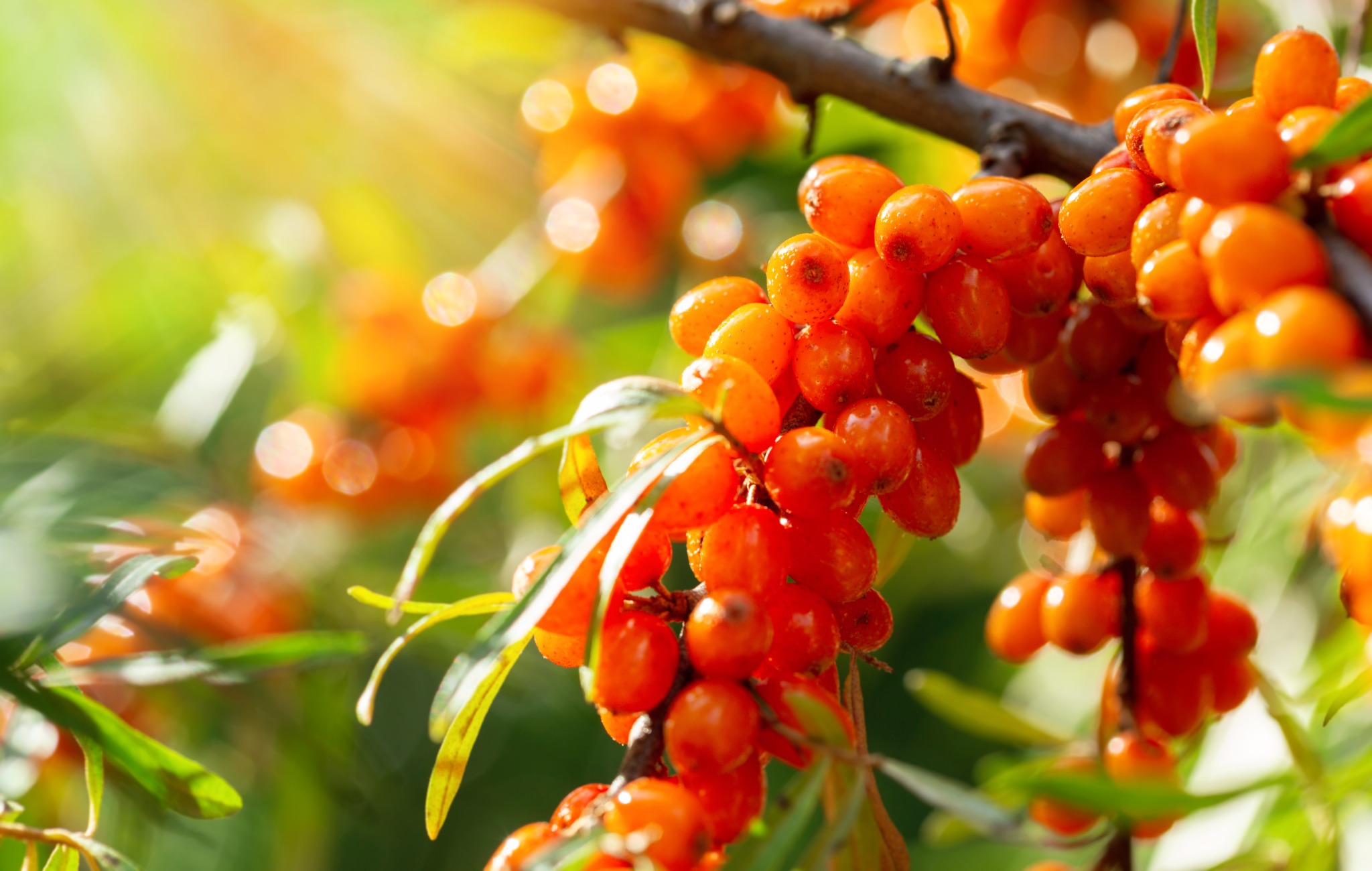 |
This dioecious shrub, with multiple branches and spines, reaches heights of 3-4 meters. Its berries, noted for their exceptional nutrient content, are spherical and turn yellow-orange or red upon ripening. Each berry, measuring about 3-8 mm in diameter, comprises a glossy, dark brown seed encased in soft, fleshy tissue. The composition of the berries includes 68% pulp, 23% seed, and approximately 7.75% peel. Due to their acidic and astringent nature, the berries are not typically consumed raw.
Sea buckthorn fruit yields a juice content of 60-85% when pressed. This juice, often combined with sweeter fruit juices like apple or grape, is used in various products including beverages, squashes, syrups, wines, beers, preserves, compotes, jams, teas (from leaves), and jellies. To reduce the fruit juice’s astringency, it’s blended with pulp from other fruits. Additionally, sea buckthorn berries find their way into pies, candies, and liquors. The oil extracted from sea buckthorn is also a popular ingredient in cosmetic products like shampoos, lotions, and creams. Commercially significant products from sea buckthorn berries include juice, oil from pulp and seeds, cream, and pigments. A notable yellow pigment, extracted from the pulp or skin, is rich in flavonones, carotene, and vitamin E. Teas made from air-dried leaves are packed with nutrients and bioactive compounds. The pulp oil, a byproduct of processing, is abundant in carotenoids, tocopherols, sterols, and predominantly contains palmitoleic acid.
Nutritionally, sea buckthorn berries are a powerhouse, rich in carbohydrates, proteins, fat-soluble vitamins, antioxidants (including vitamins C and E, beta-carotene, and lycopene), essential fatty acids, phytosterols, and flavonoids, as well as minerals like iron and calcium. They have an exceptionally high vitamin C content, surpassing that of strawberries, kiwifruit, oranges, tomatoes, carrots, and hawthorn. They are also a rich source of natural flavonoids like isorhamnetin, quercetin, and aglycones. Research indicates that sea buckthorn flavonols have minimal impact on oxidized LDL, C-reactive protein, homocysteine, and plasma antioxidant potential when consumed with oatmeal porridge. Enhancements in flavonol absorption were noted with the addition of sea buckthorn oil and increased flavonol dosage. Furthermore, sea buckthorn extracts have shown potential in inhibiting cell proliferation in Caco-2 and Hep 2 cancer cell lines in vitro. However, clinical and human intervention studies exploring its therapeutic benefits are limited. Anecdotal evidence primarily supports the medicinal use of sea buckthorn products in humans. Clinical applications of sea buckthorn seed oil have included treatment for chronic cervicitis, ulcers, and ulcerative stomatitis. In a human intervention study, significant reductions in waist circumference and vascular cell adhesion were observed in female volunteers consuming sea buckthorn berry oil. Additionally, a study indicated positive effects on liver function in cirrhotic patients, suggesting that sea buckthorn may aid in preventing liver fibrosis progression.
Blue Honeysuckle: Lonicera caerulea
Lonicera caerulea, commonly referred to as blue honeysuckle, haskap, honeyberry, or edible honeysuckle, is a mid-sized shrub bearing blue, edible fruits. Originating from the northern hemisphere, this species is part of the Caprifoliaceae family and is commercially grown in Russia and Japan.
| Blue Honeysuckle |
|---|
 |
Its fruit’s taste is often likened to a blend of blueberries and raspberries. The Lonicera caerulea shrub, ranging in height from 0.8 to 3 meters, is capable of withstanding low temperatures and can produce fruit within a year of planting. The fruits, dark navy blue to purple in color, are elongated or oval and covered with a blue waxy layer. This plant is rich in various beneficial substances including organic acids, flavonoids, iridoid glycosides, and saponins. Its berries are composed of sugars, lipids, proteins, organic acids, and polyphenols, with a lipid content of about 1.52%. Notable components found in the berries are ursolic acid, pomolic acid, and the main phenolic elements: chlorogenic, caffeic, and ferulic acids. The primary anthocyanins in Lonicera caerulea include cyanidin, peonidin, delphinidin, and pelargonidin glucosides and rutinosides. In traditional Chinese medicine, the dried bud of this plant has long been valued for its fever-reducing, detoxifying, and anti-inflammatory properties.
Exploring the Acai Palm
The Acai Palm (Euterpe oleracea Mart.), native to South America, predominantly flourishes in Brazil, Colombia, Surinam, and the Amazonian floodplains. Known as the cabbage palm, this tree produces small, purple-black fruits resembling blackberries. Brazil’s Para state is the primary acai producer, accounting for 85% of global output. The acai palm is a tall, lean, multistemmed palm with monoecious traits and feather-like leaves, reaching heights of around 80 feet. Each mature tree typically has 4-8 robust stems, with a smooth, grey trunk. Reproduction occurs through seeds and offshoots, thriving in acidic organic soil under warm, humid tropical conditions where temperatures seldom fall below 10°C. Adapted to flooded environments, it develops pneumatophores to cope with waterlogged conditions. Fruit-bearing begins at the age of three, with full productivity achieved in another three years. Harvest occurs year-round, peaking from August to December.
| Acai berries |
|---|
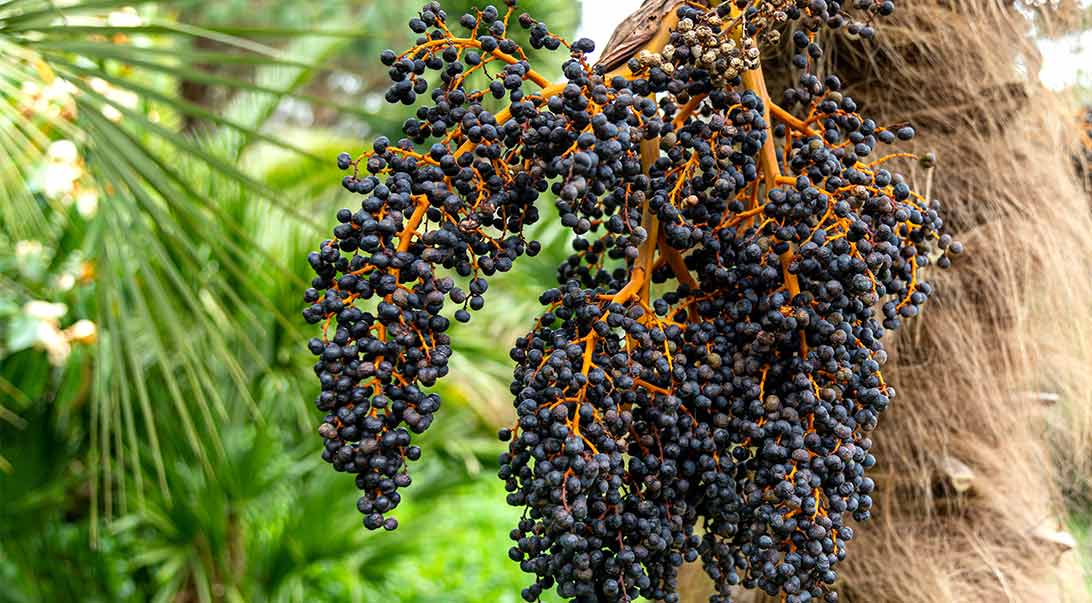 |
The acai berry, a small drupe, grows in clusters of 500-900 fruits. These spherical fruits are initially green, turning dark purple upon ripening, although some varieties remain green and are known as white acai. Each fruit, about 1-2 cm in diameter and weighing 0.8-2.3 g, comprises mostly seed (about 80%). The seed, measuring 0.6-1 cm in diameter, is encased in a tough shell surrounded by a thin, pulpy mesocarp. Depending on ripeness and variety, the fruit’s outer skin varies from green to deep purple. Acai berries are characterized by a nutty, slightly metallic taste with an oily texture.
The acai palm has gained commercial significance, especially as a superfood in the United States and North America. The U.S. market offers various acai products like fruit drinks, freeze-dried powders, powdered juice extracts in capsules, energy bars, and snacks. Locally, a thick, dark purple juice is made by mashing ripe acai berries. The primary export product blends acai juice with fruits like acerola (Malpighia emarginata) and guarana (Paullinia cupana).
Acai pulp is rich in nutrients, with lipids forming 50% and proteins about 10% of its dry matter. It boasts a high antioxidant capacity, surpassing many other anthocyanin-rich fruits and vegetables. The berry’s phytochemical composition includes a range of bioactive compounds such as anthocyanins, phenolic acids, proanthocyanidins, and flavonoids. Major anthocyanins include cyanidin 3-rutinoside and cyanidin 3-glucoside, with cyanidin 3-glucoside content varying between 11.1 to 227 mg per 100 g. The total anthocyanin content in frozen acai pulp ranges from 282 to 303 mg per 100 g. Traces of resveratrol have also been identified.
References
- Jussara palm tree (Euterpe edulis M.) açai-berry oil performance on auto- and photo-oxidation: Minor components’ stability and evolution of volatile compounds
- Isolation and characterization of a xylan with industrial and biomedical applications from edible açaí berries (Euterpe oleraceae)
- Açaí (Euterpe oleraceae Mart.) berry extract exerts neuroprotective effects against β-amyloid exposure in vitro
- Cranberry (Vaccinium macrocarpon) protects against doxorubicin-induced cardiotoxicity in rats
- Characterization of key aroma-active compounds in blue honeysuckle (Lonicera caerulea L.) berries by sensory-directed analysis
- Polyphenols from blue honeysuckle (Lonicera caerulea var. edulis) berry inhibit lipid accumulation in adipocytes by suppressing lipogenesis
- Characterization and inhibitory activities on α-amylase and α-glucosidase of the polysaccharide from blue honeysuckle berries
- Blue honeysuckle (Lonicera cearulea L. subs. edulis) berry; A rich source of some nutrients and their differences among four different cultivars
- Potentials of berries and pomegranate in management of the neurodegenerative disorders
- In vitro fermentation characteristics of blueberry anthocyanins and their impacts on gut microbiota from obese human
- Known and potential health benefits and mechanisms of blueberry anthocyanins: A review
- Protective effects of blueberries on vascular function: A narrative review of preclinical and clinical evidence
- Gastrointestinal fate of blueberry anthocyanins in ferritin-based nanocarriers
- Differential response of blueberry to the application of bacterial inoculants to improve yield, organoleptic qualities and concentration of bioactive compounds
- Structural characterization, antioxidant and antibacterial activity of three pectin polysaccharides from blueberry
- Enhancement of pyranoanthocyanin formation in blueberry wine with non-Saccharomyces yeasts
- The impact of oral sea-buckthorn oil on skin, blood markers, ocular, and vaginal health: A randomized control trial
- Sea buckthorn: A Potential Dietary supplement with multifaceted therapeutic activities
- The difference of flavonol glycosides in cultivated and wild sea buckthorn berries in China
- Comprehensive untargeted lipidomic analysis of sea buckthorn using UHPLC-HR-AM/MS/MS combined with principal component analysis
Share
Tags
Counters

